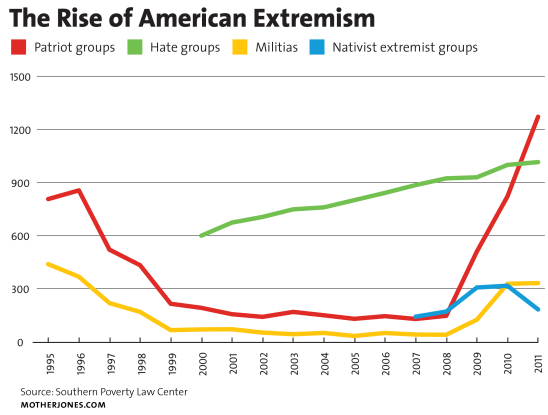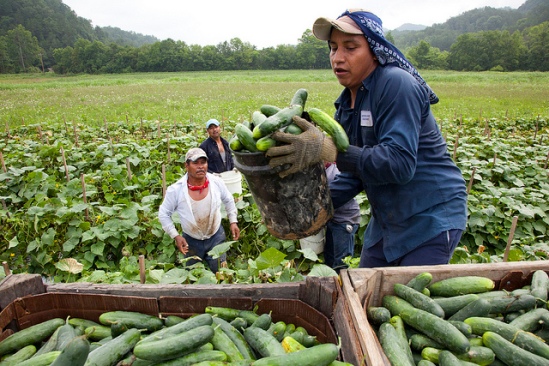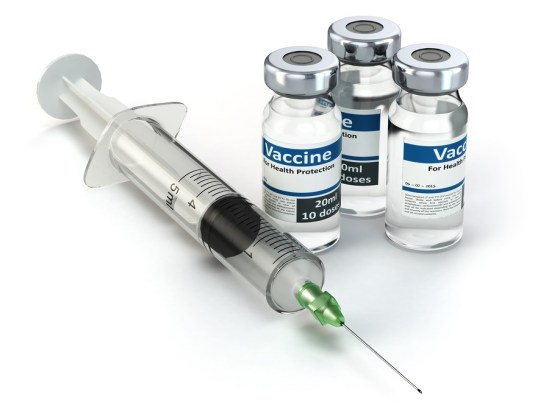
I often do my best to avoid telling parents how to raise their children. However, since it’s come to my attention that more US states are loosening their vaccination exemptions. And today a growing number of parents are refusing to vaccinate their children which I think is extremely irresponsible and dangerous to public health. Many of these parents refuse to get their kids vaccinated because internet misinformation such as the idea that vaccines cause autism promoted by Jenny McCarthy. Yet, these falling immunization rates correspond with recent resurgences of vaccine-preventable diseases. In 2010, an outbreak in California 9,120 cases of whooping cough, more than any year since the whooping cough vaccine was introduced in the 1940s. 10 babies too young to be vaccinated for the disease died during the outbreak. In some outbreaks, some children have been left severely and permanently injured or disabled. The New England Journal of Medicine said that anti-vaxxer activities resulted in a high cost to society “including damage to individual and community well-being from outbreaks of previously controlled diseases, withdrawal of vaccine manufacturers from the market, compromising of national security (in the case of anthrax and smallpox vaccines), and lost productivity.” A 2011 journal described the vaccine-autism connection as, “perhaps the most damaging medical hoax of the last 100 years.” But despite that scientific studies have debunked the non-existent vaccine-autism link, hundreds of parents still believe in this fraudulent claim and don’t get their kids vaccinated, which continue to greatly damage public health.

For all my readers on my blog and visitors, as a member of the autistic community, I sincerely plead with you not to listen to Jenny McCarthy. Sure she might have a child diagnosed with autism (or misdiagnosed), but she’s a prominent anti-vaxxer who promotes dangerous misinformation that have led to dangerous outbreaks as well as demonize a whole group of people. I may not be an expert in vaccines or autism. But I know a lot more about either than her. So listen to me instead.
I am on the autism spectrum. I have gone great lengths to avoid the subject of vaccines for as long as I could because I didn’t want people to see me as an autistic person. I didn’t want that fact to distract people from seeing me as the person I am who just happens to be autistic. Nor do I ever try to gain anything from except services I need so I can live independently from my parents someday. But since far too many people think the decision whether to get your kids vaccinated is like choosing whether you kid can have a puppy, I don’t see myself as having a choice. I may not be anywhere near as famous as Jenny McCarthy. But I consider myself more of an authority on autism than her since I am autistic though my experience doesn’t mirror everyone in the autistic community. And despite being diagnosed at 12, I’ve certainly had it long before receiving my shots like before birth. Personally, I see the anti-vaxxer idea of vaccines causing autism as resoundingly false and dangerous ideology that could lead to a public health crisis. I also find the frequently debunked autism-vaccine link deeply offensive and dehumanizing. I mean saying that vaccines cause autism is like saying that having autism is worse than contracting a potentially deadly communicable disease. Sorry, but as an autistic woman with a B.A. in history, it just doesn’t hold up for me. Have I had it hard living with autism, especially in getting a job and establishing social contacts? Yes, though I didn’t let it stop me from doing well in school and graduating from college or building up my blog and starting out as a writer. I may not be completely satisfied with my life right now and wish I had a better way to earn money than go on an exhaustive job search I see as a waste of time. But in some ways I have it better than a lot of other people in my age group. I have supportive parents and family members as well as a passion that gives me direction in life. Blogging on WordPress may not give me the money to pay my bills but at least I earn something from it and find the work more rewarding than trying to get a job.

Here’s another anti-vaxxer who has no idea of how autism and vaccines work. Yes, I know he’s an entitled rich sociopath who regularly promotes conspiracy theories on his Twitter feed and lies all the time. But somehow the Conald managed to convince over 60 million Americans to elect him president (though he didn’t win the popular vote). I know he’s an utter embarrassment and I did what I could to not make this happen. I sincerely apologize.
Vaccines are a great pillar of modern medicine. Before vaccines, life was especially brutal for children with huge portions dying from diseases like measles, smallpox, whooping cough, or rubella, along with others. Today a single injection can completely prevent these ailments in a number of ways. Nevertheless, we should never forget how many deaths and illnesses vaccines have prevented and continue to do so. Vaccines have been so beneficial to society that it’s no wonder practically all jurisdictions make them mandatory. For parents, having one’s children vaccinated on schedule isn’t just a parental responsibility but also a community obligation. Not vaccinating your kids not only leaves them exposed to danger unprotected, but also other kids and adults who can’t be vaccinated. Now that we have an anti-vaxxer in the White House, a Health and Human Services Secretary who was once part of an organization that’s espoused anti-vaxxer views, and a bullshit anti-vaxxer documentary shown at a film festival, I feel that we must debunk the falsehoods as I have in this list.
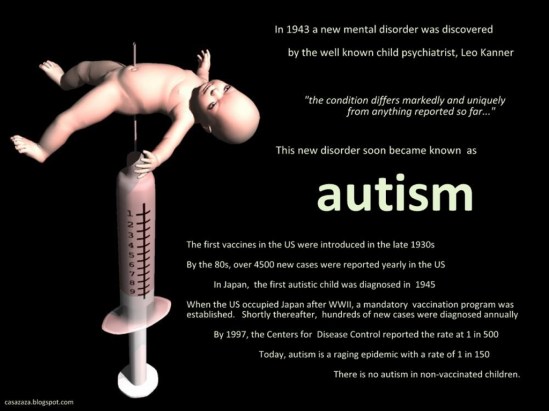
Here’s a poster with anti-vaxxer bullshit on how vaccines cause autism. Sorry, but just because vaccines and autism diagnostic rates have increased over the years doesn’t mean there’s a correlation between the two. Besides, autism was never an epidemic and its dramatic rise only indicates that it just happens to be far more common than we thought. Also, there are unvaccinated children who do have autism like those living in 3rd world countries.
- Vaccines cause autism.– Sorry, but that hypothesis has been completely discredited that 1997 Lancet article on the MMR vaccine by British surgeon Andrew Wakefield who now addressed as Mr. Wakefield these days. The Lancet eventually retracted that paper due to serious procedural errors, undisclosed financial conflicts, financial conflicts of interest, and ethical violations. Furthermore, no scientific study afterwards has found any link between vaccines and the likelihood developing autism. Oh, and the fact in 2011, a “vaccine court” ruled against over 5,000 families claiming vaccines caused their children’s autism. Though causes of autism remain a mystery, most scientists believe genetics are certainly involved and identified autistic symptoms in children well before receiving the MMR vaccine. Further research provides evidence that autism develops in utero well before the baby is born or receives vaccinations. At any rate, the most effective way to prevent your kid getting autism is avoiding sexual contact with an autistic adult. Even that’s not 100% effective due to congenital mutations, possibly environmental factors, higher paternal age, pregnancy-related conditions, and that there’s no foolproof way of knowing who’s autistic and who’s not. Hell, there’s a good chance you or someone you know might have autism and not even know it. Because while there’s been an increase of children being diagnosed with autism, there’s also been an increase in adults as well. Many times the adults are the kids’ parents who don’t find out until after their kid’s diagnosis. Also, more families are experiencing multiple members with autism than ever before. So if one kid has autism, there’s an extremely good chance their sibling will have it, too. This is especially if autistic child and their sibling are identical twins. So the cause of autism has many genetic paths sometimes through familial inheritance or congenital mutations. Let’s just say autism prevention isn’t worth it unless you either get yourself sterilized or try celibacy. If anything, it’s very likely that autism may be underdiagnosed in both kids and adults, especially among females, minorities, and the poor. As someone with autism, I find blaming vaccines for autism to be extremely offensive and irresponsible. It’s very clear that these anti-vaxxers don’t know a thing about autism and think it’s worse than having a child suffer and die from some communicable disease. Having autism wasn’t the worst thing that happened to me. But I concealed that fact for years from fellow classmates, friends, and students since I was diagnosed at 12 because I didn’t want to deal with the stigma and the fact I didn’t fit in with their idea of autism. A lot of the people I grew up with would find it almost impossible to believe that an autistic person could be substantially more intelligent and articulate than them. Yet, I also have my limitations such as sensitivity to loud noises and an inability to filter distractions which is a major reason why I still don’t have a driver’s license. While my social skills have drastically improved over the years thanks to a childhood of speech therapy at school and medications, many concepts of social interaction don’t come natural to me. And a lot of what I had to learn about social norms and communication I had to learn. When I was a little, I didn’t start talking until I was 4 years old and was a very hyperactive and curious toddler who’d often get into things I wasn’t supposed to. Oh, and I also exhibited obsessive and repetitive behaviors like lining my stuffed animals on the couch and giving them books to read. Nevertheless, it’s an integral part of who I am which I would never change though it doesn’t necessarily define me. But many anti-vaxxers and the general public don’t understand there are different recognized versions of autism along a spectrum so no two cases are the same. The rise in autism rates has more to do with the fact that scientists have redefine what constitutes it, which explains why I was diagnosed at 12 instead of 2 (though I had early intervention, medication, and speech therapy anyway). Because back in the early 1990s, autistic children were widely perceived as intellectually disabled while my toddler self could open child locks. So it was an ADHD diagnosis for me. But even when it was under the radar, I’ve always had it. There is no autism epidemic for it has always been there whether those with it have been diagnosed or not. Those autism rates don’t reflect on who has autism, they just indicate those known to have it. And most autistic people including myself don’t see their condition as a disease needing to be cured. Though they could use attention, support, and resources that all too often go to misguided efforts to find one devilish, monolithic cause of the alleged epidemic. So to say that vaccines cause autism is not only bad science that encourages parental irresponsibility, it also marginalizes people who live with a condition many people view as a disease that it’s not.

This woman’s statement on Facebook really says a lot about what I think of anti-vaxxer parents. Having child with autism isn’t as bad as having a kid suffer from a deadly communicable disease people died from. Seriously, autism isn’t the worst thing that can happen to a person.
2. Infant immune systems can’t handle so many vaccines.-In reality, infant immune systems are much more resilient than we give them credit for. Why? Because babies are exposed to countless bacteria and viruses every day. Besides, most vaccines usually contain a weakened or dead form of the bacteria or virus in order to train the immune system to fight it. And since many of these diseases contributed to high infant and child mortality rates in the past, today’s baby immune systems actually have it easy thanks to vaccines. Based on the number of antibodies present in the blood, a baby could theoretically respond to around 10,000 vaccines at one time. Even if all 14 scheduled vaccines were given at once, it would only use up slightly more than 0.1% of their immune capacity. So vaccinating infants won’t tax their immune system since their grandparents had to handle much worse at their age or older.
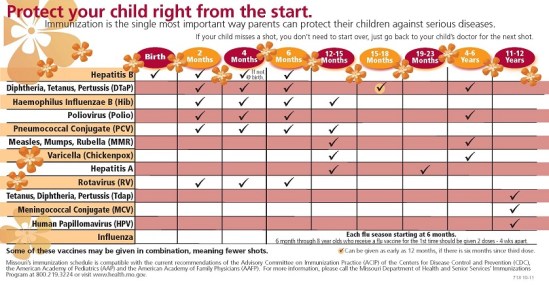
Yes, I know a lot of babies get a lot of shots as you can see from this graph. However, unlike what anti-vaxxers think, giving your baby a bunch of vaccines will only use up a very tiny fraction of their immune capacity. Also, before vaccines, then how do you think their unvaccinated ancestors survived infancy? I mean the days of pre-modern medicine had a lot of high infant mortality rates because of these bad germs.
3. Natural immunity is better than vaccine-acquired immunity.– In some cases, natural immunity like catching the disease and getting sick results in a stronger immunity to the disease than vaccination. Unfortunately, the dangers of this approach far outweigh the benefits. Of course, you could acquire a natural immunity from chicken pox with few ill effects. But contracting diseases like measles on the other hand, chances are you’d face a 1 in 500 chance of death from your symptoms. By contrast, the chance of you having a severe allergic reaction to the MMR vaccine is less than 1 in a million. Besides, even if vaccines aren’t natural so is a lot of modern medicine. So I’ll take my chances and go with the vaccine over natural immunity from deadly diseases any day of the week.
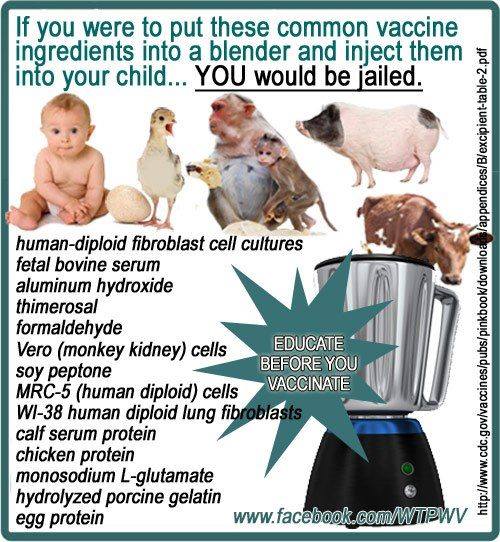
Another anti-vaxxer myth is that vaccines contain toxins like mercury, aluminum, and formaldehyde. While it may contain some truth, they are only in very trace amounts that are well within the most stringent EPA safety guidelines or not at all.
4. Vaccines contain unsafe toxins.- People have concerns about formaldehyde, mercury, and aluminum in vaccines. While these chemicals are toxic in certain levels, FDA approved vaccines only use trace amounts if any. In fact, according to the FDA and CDC, our own metabolic systems produce formaldehyde at higher rates (10 times as much in fact). There’s no scientific evidence that low levels of this chemical, mercury, or aluminum are harmful. If you’re still worried, remember that childhood vaccines haven’t contained any mercury since 1999. And when they did, the mercury levels were well below the EPA’s most stringent public safety limits. So even if your kid received a vaccine containing thimerosal, the overwhelming majority of data supports a lack of association between the substance and neurological problems. And that children are exposed to mercury from many environmental sources that according to Dr. Margaret Rennels, “The reality that a lot of people seem to miss is that the largest source of organic mercury is the environment: the air we breathe, the water we drink and the fish we eat. That’s due to the burning of coal.” As for aluminum, babies get more of that from food even in the first 6 months whether be from breast-feeding or formula.
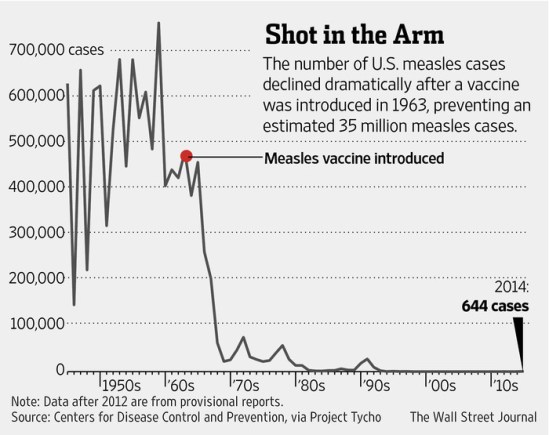
While better sanitation, nutrition, personal hygiene habits, and antibiotics have helped decrease infections, they don’t explain the whole story. I’ll let this graph from The Wall Street Journal speak for itself. Or you can just ask a celebrity polio survivor (they do exist).
5. Better hygiene and sanitation are actually responsible for decreased infections, not vaccines.- Sure better hygiene and sanitation have helped reduce or eliminate infectious disease rates. But so have better nutrition and the development of antibiotics as well. However, when we isolate these factors and scrutinize infectious disease rates, vaccines’ role can’t be denied. Because many infections can still spread regardless of how clean we are. For instance, when the first measles vaccine came out in 1963, infection rates had held steady at 400,000 cases a year. Hygienic and sanitation didn’t change much during the following decade, but measles infections dropped dramatically with only 25,000 cases by 1970. Another example is Hib disease. According to the CDC, its incidence rate plummeted from 20,000 in 1990 to around 1,500 in 1993 after the vaccine was introduced.
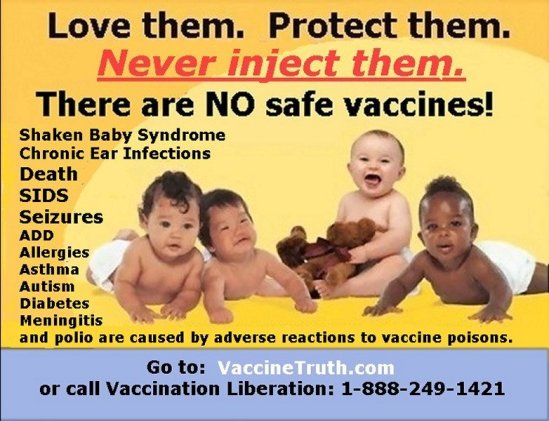
As you see from this rag of lies, anti-vaxxers like to go out of their way to show that vaccines aren’t worth the risk. However, while vaccines do cause severe allergic reactions, the overall incident rate is like 1 in 2 million. Perhaps you should worry about bigger dangers to your children like meteors or lightning strikes.
6. Vaccines aren’t worth the risk.– Children have been successfully vaccinated for decades that there has never been a single credible study linking vaccines to long term health conditions. As for immediate danger like allergic reactions or severe side effects, the incidence of death is so rare they can’t ever truly be calculated. For example, the CDC reported only one death attributable to a vaccine between 1990 and 1992. The overall incident rate of severe allergic reactions to vaccines is usually placed around one case for every 2 million injections. Besides, vaccines are tested in more children over a longer period of time than any other drug. And when introducing a new vaccine, the FDA requires pharmaceutical companies to prove their product doesn’t pose a threat when added to the existing vaccine schedule. There’s even as special database called the U.S. Vaccine Adverse Event Reporting System (VAERS) which can help scientists monitor vaccine safety and anyone can use the system to report a suspected side effect. And in many cases, the side effects reported are mostly coincidences and of the people who reported to VAERS about vaccines causing autism, 80% were personal injury lawyers. Not to mention, vaccine makers often take a cautious approach when writing their warning labels, listing all possible side effects even if they occur at the same rate in unvaccinated people. So your child is more likely to die from being struck by a meteor than from a vaccination.
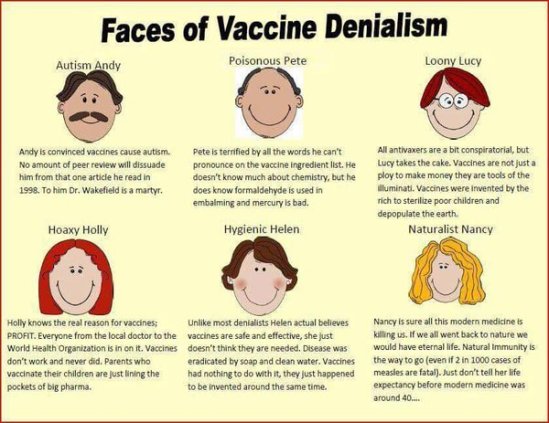
Here’s a chart on the types of vaccine denialists. There’s Autism Andy, Poisonous Pete, Loony Lucy, Hygenic Helen, and Naturalist Nancy. Each is an unreliable steaming pile of shit who shouldn’t be trusted.
7. Vaccines can infect children with the disease it’s trying to prevent.– Vaccines can cause mild symptoms resembling those from the disease they’re protecting against. It’s a common misconception is that these symptoms signal infection. In reality, in the less than small percentage of (less than 1 million cases) where symptoms do occur, the vaccine recipients are experiencing a body’s immune response to the vaccine, not the disease itself. There’s only one recorded instance in which the vaccine was shown to cause disease. This was the Oral Polio Vaccine (OPV), which is no longer used in the US. Since then, vaccines have been in safe use for decades and follow strict FDA regulations. Today, according to Kathryn Edwards, M.D., spokesperson for the National Network for Immunization Information, “Most vaccines we give today, such as meningitis and DTaP, contain killed vaccines—not live agents that could replicate.” Though there are some vaccines that do contain a live weakened virus to provoke an immune response such as the MMR and chicken pox immunizations.
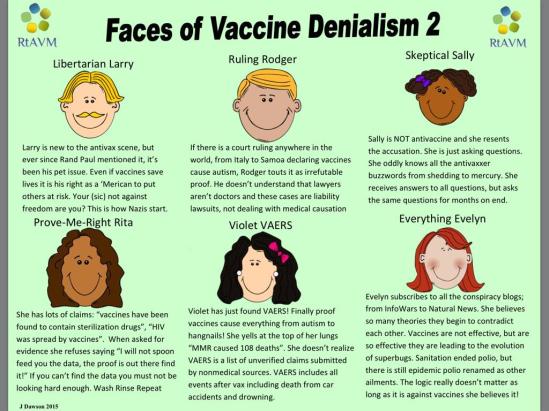
Here’s some more faces of vaccine denialism we’ll get to. There’s Libertarian Larry, Ruling Roger, Skeptical Sally, Prove-Me-Right Rita, Violet VAERS, and Everything Evelyn. Again, a bunch of wackjobs.
8. We don’t need to vaccinate because infection rates are already so low in the United States.- The fact infection rates are already so low in the US is because we’ve been vaccinating our kids for decades because the virus and bacteria responsible for these diseases don’t go away. Thanks to “herd immunity,” so long as a large majority of people are immunized in any population, even the unimmunized minority will be protected. With so many people resistant, an infectious disease will never get the chance to establish itself and spread. This is important because there will always be a portion of the population like infants, pregnant women, elderly, and those with weakened immune systems who can’t receive the vaccines. But if too many people don’t vaccinate themselves and their children, they contribute to collective danger and open up opportunities for viruses and bacteria to establish themselves and spread. Not to mention, since international travel is growing quickly, the CDC warn that even if a disease isn’t a threat to your country, it may be common elsewhere. If someone carries in a trip from abroad, an unvaccinated individual will be at far greater risk of getting sick if they’re exposed.

Vaccines are very instrumental in the concept of “herd immunity.” This works when a large population gets vaccinated against a deadly virus, they can contain infectious individuals and protect those who can’t get vaccinated. If not enough people are unvaccinated, deadly diseases can come back. So for those who says as long as other kids get vaccinated that your kids don’t need to be, you totally do. Unless you’re Amish or live under a rock.
9. As long as other children are getting vaccinated, mine don’t need to be.- Sorry, but skipping your kid’s vaccinations puts your kids at greater risk for potentially life-threatening diseases. Besides, there’s the whole “herd immunity” thing you don’t understand in which according to Professor Thomas Saari, M.D., “The ability of immunizations to prevent the spread of infection depends on having a certain number of children immunized.” And the immunization level required to prevent most of these vaccinable diseases is very high. For instance, in order for the herd immunity to prevent measles from being spread from child to child, the 95% of kids have to be vaccinated against it. In 2003, the national vaccination rate in the US in children between 19-35 months was only about 80% despite that the number increases to the mid-90s when kids are starting school. Such rates may not be high enough to provide herd immunity, especially if exemptions from school vaccines are on the rise in some states. According to studies from Colorado where residents claim high numbers of vaccine exemptions for medical, personal or religious reasons, kids who aren’t immunized pose a greater risk for disease like 22 times to come down with measles.
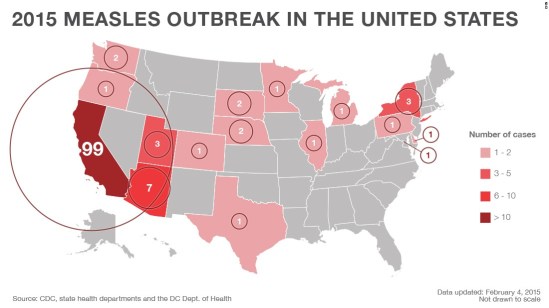
When enough parents listen to Jenny McCarthy instead of get their kids vaccinated like they’re supposed to, the disease causing agents weasle their way back and cause outbreaks with a vengeance. Look at the map of the 2015 measles outbreak from the CDC, people.
10. Now that major illnesses have largely disappeared, we really don’t need vaccines anymore.- That analogy is similar to what Republicans and libertarians say now that working conditions have improved, we no longer need unions and regulations. Or how some say now that the Civil Rights Movement did away with social discrimination, we no longer need civil rights protections on certain demographics. Or how some say that now that we have clean air and water thanks to the EPA, we no longer need environmental protections. Except you do because the propensity to commit such social injustice still lingers on as we know by the election of President Pussygrabber. The same logic applies to vaccines because despite relatively high vaccination rates in the US, many American communities still have outbreaks of diseases like measles and pertussis, a respiratory illness characterized by spasms of coughing that can last for weeks or even months. In 2003, 13 kids died from the infection. Unvaccinated children can also spread infection to vulnerable family members. According to Dr. Saari in Parenting Magazine, “Those children are more likely to give a disease to those who can’t fight it off, such as a six-month-old or a grandparent living at home.” One case is the incidence of whooping cough which has been increasing since the 1980s, and the CDC has recommended a pertussis booster shot for 11-year-olds because the risk of passing the disease to a vulnerable relative is so high. Also, if you remember reports about panics involving Zika and Ebola, diseases are spread by people from foreign countries who travel here. As Dr. Saari said, “Air travel has extended the range of diseases from countries where people aren’t immunized. We’re no more than one airplane ride from being exposed to many diseases.” Thus, if people aren’t vaccinated, these supposedly uncommon diseases can come back.
11. You shouldn’t give a vaccine to a child who has a cold.– You might think that a sick child would be more likely to have a bad reaction to a vaccine or that it might present and added burden to their immune systems if they’re fighting a cold. However, studies show that a mild illness doesn’t affect a child’s ability to react appropriately to the vaccine. As Dr. Rennels says, “Certainly if a child comes in with a fever of 102 and a rip-snorting ear infection, it’s not the best time for a vaccine. But a low-grade fever, mild respiratory infection or a little diarrhea shouldn’t be reasons to delay one, especially if the illness is on the way out.” Of course, vaccines can trigger side effects such as a fever and rash as well as soreness at the injection site, but these are rarely cause for alarm. The 5-in-1 Pediarix is more likely to cause a low fever than the individual shots are, but many moms say the fewer injections for their child, the better. But if your child has hives (which can indicate an allergic reaction), a fever of 105 degrees or higher, or convulsions, call your doctor right away.
12. I had chicken pox when I was a kid and it isn’t a big deal.– So did I and so did my sister. But my parents tried to get us vaccinated for it anyway before there was no longer any need to. Sure chicken pox may not be a big deal for most kids but on rare occasions, children can die from it. Before the vaccine was introduced, many children were hospitalized each year with serious complications, including pneumonia and dangerous skin infections. According to Dr. Rennels, “Chicken pox lesions can become infected with staph, including necrotizing fasciitis—the ‘flesh-eating’ bacteria.” Getting the chicken pox vaccine is especially important now that less of the virus is in circulation. And as Dr. Rennels adds, “Children who don’t get chicken pox or the vaccine are at risk of getting it as an adult, which is a much more serious illness.” Besides, I had a kid in my class who had chicken pox during our junior year in high school and he was out for days.

Vaccines may not be 100% effective. But they’re effective enough that you won’t need get well gifts like these when you get the diseases vaccines are supposed to prevent.
13. Vaccines can provide 100 percent disease protection.- Vaccines may not be 100% effective (though the effect rate can range from 75-95% which still very good) and it’s possible you can be vaccinated against a disease and still get it. But if all children are vaccinated against an organism, it’s less likely to hang around. Again, we have herd immunity kicking in, which is why vaccinating an entire population is crucial. As Dr. Edwards says, “Not getting vaccinated is like failing to stop at a four-way stop. If three people get vaccinated but one doesn’t, the risk is not bad. But if two people don’t get vaccinated, the burden of risk is greater on everyone.”
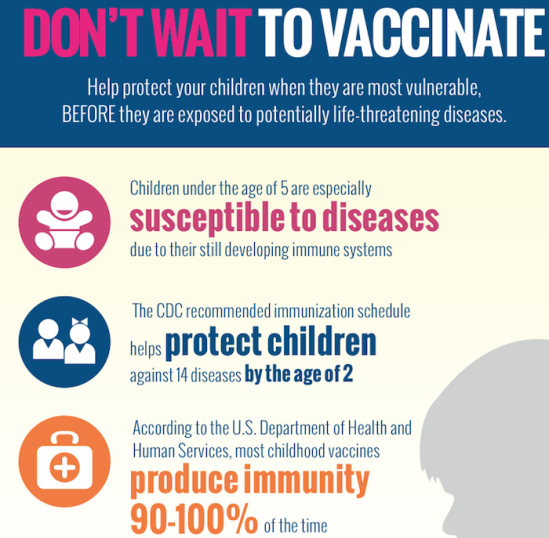
Some anti-vaxxer parents think it’s better to wait until their kids are older to get the vaccinations. However, the reason why vaccine schedules are designed the way they are is that small children are the most vulnerable to contracting them. Remember how historical times witnessed high infant mortality rates.
14. It’s best to wait until children are older before starting to give them vaccines.- The best time to get your kids vaccinated against the disease, is at the earliest possible moment they can get it. Immunization schedules are designed to protect the most vulnerable patients from disease. If you wait to give the vaccine, you might miss the window when a child is most vulnerable. We should also remember that many of these infectious diseases we vaccinated against have killed high numbers of infants and small children. So you get off the schedule, you put your child at risk. One instance in Wisconsin had 300 children under the age of 1 come down with whooping cough with 177 less than 6 months old. Half of these babies were hospitalized and 3 died. For a kid to die of whooping cough nowadays is criminal.
15. It’s safe to space out vaccinations.- Spacing out vaccines may actually cause children more distress. Sure kids don’t like getting several shots at once. But studies show that a child’s stress hormones peak after one shot while additional needlesticks doesn’t increase their distress. So it’s better to get several shots out of the way in one doctor’s visit than once a month. Besides, postponing shots leave babies at risk and none of the alternative schedules has been clinically tested. As Ari Brown says, “There is absolutely no research that says delaying certain shots is safer. Doctors who promote these schedules are simply guessing when to give which shots. What we know for certain is that delaying your child’s shots is playing Russian roulette.”

When anti-vaxxers say that vaccine-preventable diseases aren’t that dangerous, they’re usually thinking about relatively less severe ones like chicken pox. This picture depicts a polio ward with kids being encased in iron lungs. Polio was a menace because it could kill or leave its victims permanently disabled. Dr. Salk’s discovery of the polio vaccine in the 1950s was seen as a medical miracle. Let that sink in.
16. Vaccine-preventable diseases aren’t that dangerous. – Sorry, but as a history major, I think anyone who believes this bullshit have absolutely no fucking idea. Sure they may have had chicken pox as a kid which is usually not very dangerous. But if you think that most vaccine-preventable diseases are like chicken pox, you’re a fucking moron. Vaccines have eliminated diseases that have once sickened, disabled, or killed hundreds of thousands of people. Because few young parents have encountered any of these diseases and possibly not know a thing about science or history, they don’t realize how dangerous they are. Whooping cough once sickened 300,000 people a year and killed 7,000 mostly young children. A better example would be polio which ravaged the country so much that when Dr. Jonas Salk discovered the vaccine and gave it away for free, he was seen as nothing less than a miracle worker. But before that, polio was a nightmare virus that parents and children feared because it was contagious disease that paralyzed and killed people. Surviving the disease could be a life changing experience leaving some permanently physically disabled to varying degrees while remember the fear and isolation. It crippled Franklin Delano Roosevelt that he nearly ended his political career over it, which could’ve shaped the US quite differently had he not ran for Governor of New York and later president during the Great Depression. Hell, we have plenty of celebrities who’ve survived polio and are still alive like Alan Alda, Donald Sutherland, Mia Farrow, Donovan, Joni Mitchell, Itzhak Perlman, Neil Young, and Sir Ken Robinson.

This is US President Franklin Delano Roosevelt. In 1921, he came down with polio during vacation at Campobello that would leave him crippled from the waist down. He would be confined to wheelchair and walk with braces for the rest of his life. And he nearly ended his political career of this. Nevertheless, he’s an example what vaccine preventable diseases did to people.
17. Only sick people need flu shots and other vaccines.- As with herd immunity when healthy people get vaccinated, it can help protect the weak, including cancer patients, anyone with compromised immune systems, and newborns too young to get the shot. Because babies can’t begin common vaccinations until they’re 2 months old, they depend on those around them for disease protection whether they be family, hospital staff, or babysitters.
18. Vaccines contain tissue from aborted fetuses.- No they don’t. And even if they did, the National Catholic Bioethics Center has said that Catholics are, “morally free to use the vaccine, regardless of its historical association with abortion. The reason is that the risk to public health, if one chooses not to vaccinate, outweighs the legitimate concern about the origins of the vaccine. This is especially important for parents, who have a moral obligation to protect the life and health of their children and those around them. … It is important to note that descendant cells are not the cells of the aborted child. They never, themselves, formed a part of the victim’s body.” Anyway, fetal tissue has been used in the development of some vaccines like hepatitis A, chicken pox, and rabies. But the best example is in rubella during the 1960s since it involved isolating the virus from the tissue of fetuses whose mothers have had it. The women chose abortion due to concerns about birth defects caused by rubella which include deafness, heart disease, mental retardation, a devastating brain inflammation called encephalitis and pneumonia. Though in any case, the viruses were often purified before being used in vaccines and no human cells remain in the final shots given to children.
19. Vaccinated children can shed virus and infect others.- Only one vaccine has been known to do this which was the liquid OPV and it was one time. Even then children vaccinated with OPV could shed the virus through their feces and spread it to other kids who didn’t wash their hands after going to the bathroom. In the process, they could protect those kids against the virus. Doctors call this phenomenon, “contact immunity,” and it was a useful trait in the 1950s, when the country was ravaged by polio, because vaccinating one child against polio could help to indirectly vaccinate others. After polio had been eliminated in the US by 2000, American doctors stopped using the live virus and have resorted to killed polio vaccines from then on. No other vaccine has been known to shed so kids vaccinated against measles won’t spread the disease to other kids spreading the virus. In fact, measles can only spread when people are actually sick with the disease and showing symptoms.
20. Vaccines cause autoimmune disease.- According to Medscape, “The role of vaccination in the pathogenesis of autoimmune diseases (presumably by triggering autoimmunity) has long been a matter of debate. Although the cause of these diseases is still unclear, several factors, including genetic predisposition, environmental factors, and infectious diseases, may play a role. The relationship between vaccines and autoimmunity is still under study; however, no definitive evidence supporting a causative association exists to date. Most of the data linking vaccines with autoimmunity comes from case studies, which are considered to offer a low level of evidence. So far, no large epidemiologic studies have been conducted to provide us with relevant compelling clinical evidence. Given the nature and heterogeneity of autoimmune disorders, such studies are very difficult to be performed.”
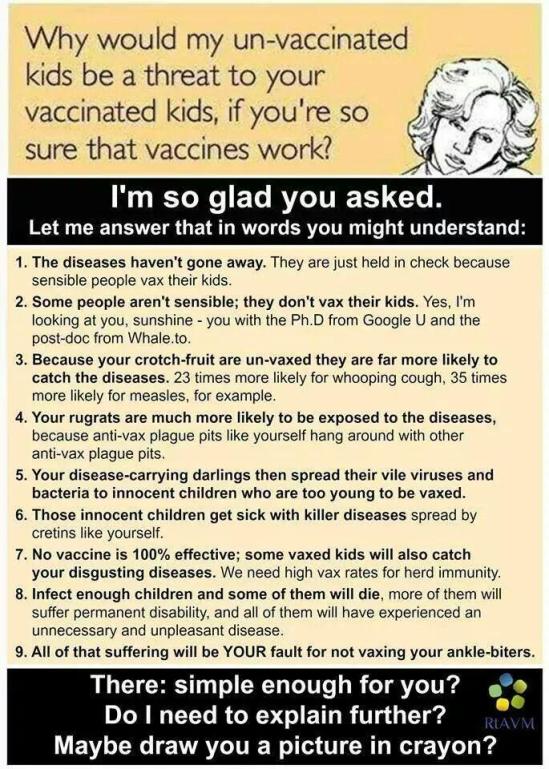
Here’s a good poster of why every kid should be vaccinated. And yes a lot of myths are listed on here. Yeah, it’s that simple.
21. Influenza is a harmless illness, so vaccination is unnecessary.- According to Medscape, “Although influenza is commonly considered to be a mild illness, this is certainly not always the case. Influenza is a large threat to public health, with three pandemics and millions of deaths from influenza in the 20th century. During the last pandemic period of the H1N1 virus (June 11, 2009 to August 1, 2010), 18,449 deaths were attributed to influenza, although the global death rate was certainly higher. Influenza can have serious complications, including severe pneumonia, and extrarespiratory complications, such as encephalopathy and myocarditis. In addition, a considerable number of deaths related to cardiac and pulmonary complications typically follow influenza epidemics. Particularly among the elderly, people with underlying medical conditions, and pregnant women, the risk for influenza-associated complications is higher and flu vaccination is strongly recommended.”

Most vaccines aren’t only safe for pregnant women, two are also recommended. One of these is the flu shot while the other is the TDaP vaccine taken in the third trimester. Not only does this protect the mother, but the baby, too. Which is great because many newborns can’t be vaccinated.
22. Vaccines shouldn’t be administered to pregnant women.- Most vaccines aren’t only safe during pregnancy, but highly recommended. Two vaccines are especially important such as the flu vaccine and the Tdap (tetanus, diphtheria, acellular pertussis) given between 27 and 36 weeks. According to Medscape, “Tetanus, pertussis, and influenza are diseases with potentially severe consequences for the child and/or the mother that can be prevented through vaccination. The vaccination of a pregnant woman against pertussis offers substantial protection of the newborn against this infection.” Medscape adds, “An evaluation of the available data suggests that vaccines containing inactivated microorganisms are safe for administration during any week of pregnancy. Influenza, in particular, can be very severe during pregnancy, thus it is recommended that pregnant women receive flu vaccination during flu season.” There has been no evidence that the flu vaccine has contributed to any congenital malformations. Same goes for any other vaccines.
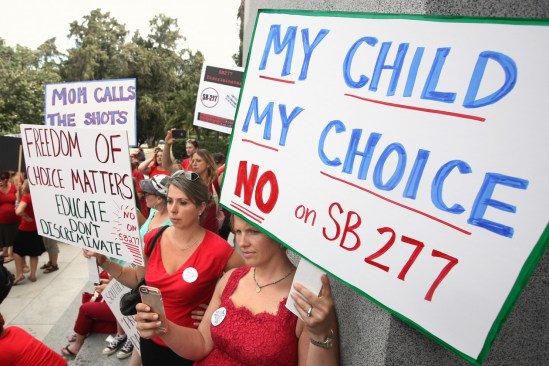
Many Anti-vaxxers think vaccinating their children should be a personal choice instead of mandatory, claiming that mandatory vaccinations violate their civil rights. Sure it’s only a personal decision if it only affects themselves. But unfortunately, with herd immunity involved, vaccines don’t work that way.
23. Mandatory vaccination violate civil rights.- Sorry, but this has no basis in reality. Massachusetts enacted the first mandatory vaccination law in the US in 1809. Nearly 100 years the Supreme Court ruled mandatory vaccination laws constitutional with the case of Jacobson v. Massachusetts. Though all states do offer medical exemptions. Nevertheless, parents need to be aware that if don’t vaccinate their kids, they’re putting them and their contacts at risk of serious disease. And unvaccinated children often have to stay home from school or daycare during outbreaks. Besides, what about those who can’t get vaccinated? Don’t they have a right to not contract a serious vaccine-preventable disease that won’t kill them? Don’t they have a right to herd immunity protection?

VAERS is a reporting system on vaccine reactions from the US federal government. Anyone can report anything on it. Nevertheless, despite what Anti-Vaxxer testify, VAERS data doesn’t prove anything. Nevertheless, here’s a VAERS form.
24. VAERS data proves that vaccines are dangerous.- VAERS data actually can’t “prove” anything. On VAERS anyone can report anything as “no proof of causality is required” while only reports of special interests like hospitalizations are verified. Even when checked, many reports aren’t accurate while many include non-serious reactions. The number of reported to adverse events is usually influenced by publicity. Besides, VAERS just exists to properly detect early warning signals and to generate hypotheses. It’s not meant to inform people about vaccine since it’s more of a suggestion box open to the public.

There’s an anti-vaxxer children’s book out there I had on one of my book cover posts called Melanie’s Marvelous Measles. Here are some other anti-vaxxer follow ups. Enjoy.
25. More people die from the vaccine than from measles.- For God’s sake, this is utter bullshit. In reality, according to the World Health Organization, measles kills 140,000 people a year globally while the measles vaccine saves 1 million lives annually. By contrast, there have only been 57 deaths due to measles vaccines filed through the federal Vaccine Injury Compensation Program, which is a no-fault system set up to compensate people injured by vaccines. The program doesn’t say how many of these claims are allowed. Nevertheless, while vaccines aren’t 100% safe, a person’s chance of dying from the vaccine are miniscule compared to their astronomical chance of being saved.
26. Existence of the Vaccine Injury Compensation Program proves that vaccines are harmful.- Sure vaccines aren’t 100% safe as with any product since there are people who are allergic to it. However, vaccines are so safe that your chances of dying from one are less than being struck by a meteor. Nevertheless, the Vaccine Injury Compensation Program was launched in 1986 because vaccine makers were dropping out of the business out of fear of pricey lawsuits. Public health officials feared that the US would suffer a vaccine shortage. Nevertheless, under the Vaccine Injury Compensation Program, if people can prove they suffered an injury known to be caused by a vaccine, they could be compensated without having to prove the vaccine caused the problem. And it’s paid for by a tax on vaccines.
27. Foreigners, especially undocumented immigrants, are bringing measles to the US. – It’s true that measles was eliminated from the US in 2000 and that all outbreaks now begin with an imported case. But in 2014 which was the worst year for measles since 1994, 635 out of 644 cases involved US citizens. And out of them 77% were unvaccinated people. What’s happening is that unvaccinated Americans are going to countries where measles is more common and bringing the virus back. Unless they live in a community where many people aren’t vaccinated like Amish country, usually they don’t infect very many people. But when measles happens anywhere in the world, it can come here on a plane pretty quick. And it’s not coming over land borders because high vaccination rates in the Americas has eliminated measles there. Rather it’s more likely coming from Europe, Asia, and the Philippines.

This Natural News graph shows the often debunked anti-vaxxer myth that Big Pharma profits from them. In reality, doctors, drug makers, and insurance companies actually lose money from vaccines since they’re so labor intensive. Also, you shouldn’t trust Natural News as a viable news site. Since it’s full of conspiracy theories like this one.
28. Doctors and insurance companies promote vaccination to drive profits.- Actually doctors and insurers don’t profit from vaccination in any way. Some insurers pay the cost of vaccination to prevent having to pay more later if a patient gets sick. And a 2009 study found that 1 out of 3 doctors actually lose money when giving vaccines. Also, big Pharma only makes 1.5% of their income on vaccines anyway and only 5 companies make 80% of them that there have been problems in vaccine supply and fact making them is so labor intensive.
29. The DTaP (diphtheria, tetanus and pertussis) and the polio vaccines cause sudden infant death syndrome (SIDS). – There’s no evidence these vaccines cause SIDS. 90% of SIDS cases occur before the infant is 6 months old with the highest rates between 1 and 4 months of age. Unfortunately, this is the age group when children are scheduled to be vaccinated against DTaP and polio. The SIDS deaths are co-incidental to vaccination and would’ve occurred even if the child hadn’t been given the vaccines. This is especially if the infant didn’t sleep in a crib with proper bedding, wasn’t in a proper sleeping arrangement or position, or had parent who smokes. Not to mention, these vaccines have been linked to a 50% lower risk of SIDS.
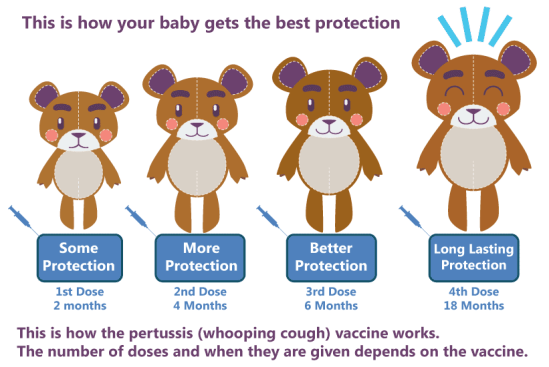
Some people may believe that one shot is enough protection. However, some vaccines take multiple doses since one shot isn’t enough like the whooping cough one you see here.
30. One vaccine in a series gives a child enough protection.- Getting the recommended dose of each recommended vaccine provides a child with the best protection possible. Depending on the vaccine, more than one dose is needed to build high enough immunity to prevent disease, boost immunity that fades over time, make sure people who did not get immunity from a first dose are protected, or protect against germs that change over time, like flu. Every vaccine dose is important because they all protect against infectious diseases that are threats today and can be especially serious for infants and very young children. Skipping vaccines puts children at risk for contracting the diseases, especially measles and pertussis. Thus, if the recommendations are for a series of shots, make sure your child receives all of them so they’re not left unprotected.
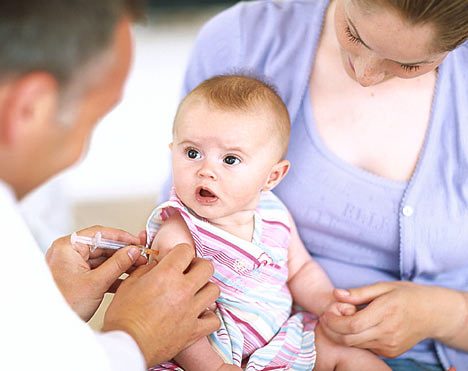
Of course, nobody likes receiving a shot from the doctor, especially babies who are likely to scream and cry. However, while giving them a TDaP shot today might your little one cry, it’ll keep them from constantly screaming in agony from diphtheria later.
31. Shots are very painful to a baby. – Indeed they are but the pain is only momentary and not significant. Besides, studies show there are ways to minimizing the pain your baby feels such as being breastfed before or afterwards as well as being held and distracted by their parents. The doctor could even give the baby numbing cream or a sugar solution. Yet, even if you don’t resort to any of this, at worst a small prick of a needle will only cause enough pain that might instill a lifelong fear of shots. Yet, this is a small price for protecting them against a world of pain from the serious diseases the vaccine protects against.
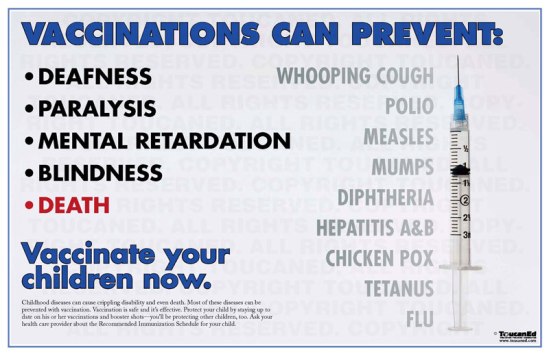
Contrary to anti-vaxxer logic, vaccines don’t weaken immune systems. If anything, they usually strengthen the immune system from diseases that can compromise it and leave people more vulnerable to other infections as well as serious health problems.
32. Vaccines weaken the immune system. – Vaccines usually contain a weakened if not dead form of the virus so they can train the immune system in to fighting them without causing infection. Natural infections on the other hand, can weaken the immune system by preventing some people from fighting off other viruses and bacteria easily. This happens most notably in children during a natural infection like chicken pox or measles. And the fact so many small children died of serious diseases before we had vaccines for them illustrates why we have them in the first place.

While vaccinations aren’t 100% effective, they are certainly necessary as this graph certainly shows. And because of vaccines, these infectious disease rates have plummeted. But if at least 95% of the American public don’t receive their shots, these germs could infect with a vengeance. So yes, vaccines are necessary and if you haven’t already, vaccinate your kids.
33. Since most vaccines are not 100% effective, there’s really no need to get them. – Just because something doesn’t work 100% of the time doesn’t mean there’s no real need to have it, especially if it could save your life. For instance, wearing seatbelt may not guarantee my survival in a car crash. But I’d have to be an idiot not to wear one every time I ride in a car. Sure vaccines aren’t 100% effective but most have an 85-99% protection rate which makes it the best way to avoid these diseases. In addition, for some vaccine-preventable diseases, the serious effects of the disease may be less for someone who’s received the vaccine. And the more people who get the vaccine, the less likely the disease will be present in the community where it can spread to people unable to get the vaccine either due to being too young or having certain medical conditions. This is known as “herd immunity.” So yes, getting the vaccine is worth it.
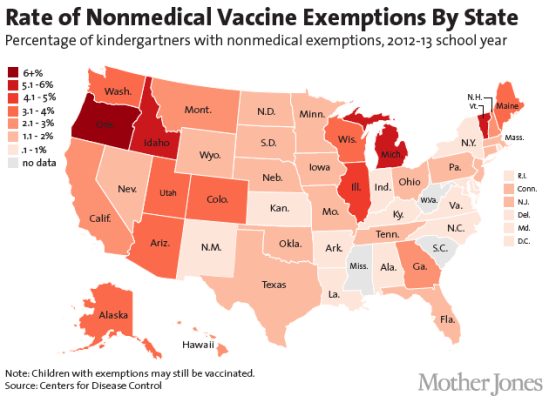
In recent years, the rate of nonmedical exemptions from vaccines has risen thanks to the rise of anti-vaxxer conspiracy theories. Along with that comes a higher prevalence of outbreaks pertaining to vaccine-preventable infections. And these endanger the most vulnerable such as newborn babies. We need to understand that vaccine shouldn’t be a choice most of the time.
34. More vaccinated people get the disease than the unvaccinated. – Yes, but that’s because vaccines aren’t 100% effective so it’s still possible to get the disease being vaccinated against. However, if you do get the disease, you’ll only suffer fewer complications and long term effects than those who are unprotected. For instance, with pertussis (whooping cough), severe complications such as pneumonia and encephalitis (brain inflammation) occur almost exclusively in the unvaccinated. Both of these could either cause permanent damage in small children or kill them. However, the fact vaccines aren’t 100% effective don’t mean that they don’t work.
35. There are “hot lots” of vaccine that have been associated with more adverse events and deaths than others. Parents should find the numbers of these lots and not allow their children to receive vaccines from them.- This gets a lot of publicity but the concept of “hot lot” used in this context is wrong. This is based on the presumption that the more reports of adverse events a vaccine lot is associated with, the more dangerous the vaccine is in that lot. And that by consulting a list of reports per lot, a parent can identify which ones to avoid. According to WHO, this is misleading for 2 reasons. First, and adverse report following vaccination doesn’t mean that the vaccine caused the event. In fact, statistically, a certain number of serious illnesses, even deaths, can be expected to occur by chance alone among kids recently vaccinated. Besides, no scientific study has ever linked vaccines to any serious long-term health problems. Second, vaccine lots aren’t all the same with sizes varying from several hundred thousand to several million. According to WHO, “Naturally a larger lot or one that is in distribution for a longer period will be associated with more adverse events, simply by chance. Also, more coincidental deaths are associated with vaccines given in infancy than later in childhood, since the background death rates for children are highest during the first year of life. So knowing that lot A has been associated with x number of adverse events while lot B has been associated with y number would not necessarily say anything about the relative safety of the two lots, even if the vaccine did cause the event.”
36. Only children need vaccinations.- Look, I may not always get the flu shot every year even though I know I need it. But vaccine-preventable diseases continue to be a threat throughout our lives. According to the California Department of Public Health, “Adolescents need boosters for many childhood diseases, some college age students need protection from meningitis, adults need vaccines for shingles and pneumonia, and everyone needs the flu vaccine and, especially for those around infants, the pertussis vaccine.” We should also acknowledge that Franklin Delano Roosevelt contracted polio as an adult in the 1920s. So while infants and young children are the most vulnerable to vaccine-preventable diseases, they can and have killed adults. Just look at history or old timey literature.

Yeah, this pretty much sums up anti-vaxxers in a nutshell. Pretty much people with dangerous ideas. So if you’re skeptical about vaccinating your kids, just do it. Believe me, don’t listen to anti-vaxxer celebrities like Jenny McCarthy, Robert DeNiro, or Jim Carrey. Instead, listen to the medical community who know what they’re talking about. Sure some may be anti-vaxxers, but most of them aren’t.


























































































































































































































































































































































